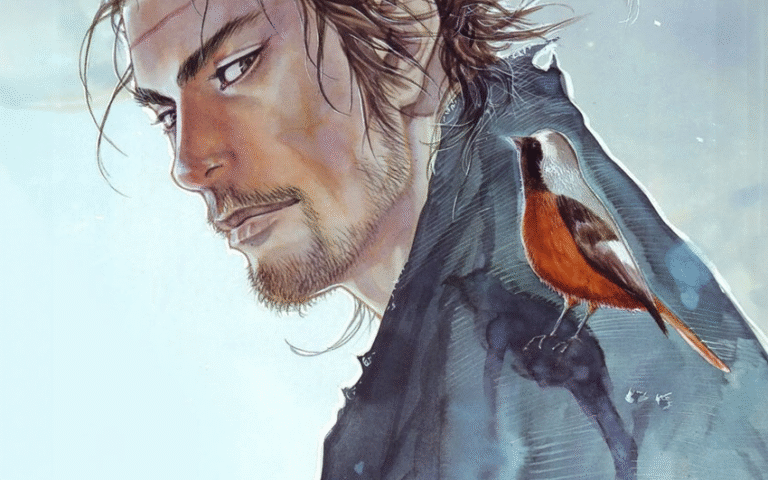Sasaki Kojiro Vagabond – The Deaf Swordsman with Divine Skill
Introduction to Sasaki Kojiro in Vagabond
In the world of Vagabond, a manga masterpiece by Takehiko Inoue, many characters leave lasting impressions, but none are quite as enigmatic or beloved as Sasaki Kojiro. While the manga primarily follows Miyamoto Musashi, it is Sasaki Kojiro’s character who balances the narrative with grace, innocence, and godlike swordsmanship.

Unlike most fictional warriors, Sasaki Kojiro in Vagabond manga is not a copy of historical reality. Instead, he is reimagined as a deaf swordsman, making his character even more compelling and deeply symbolic.
Who Is Sasaki Kojiro in Vagabond?
Sasaki Kojiro is portrayed as a mute and deaf child who develops a supernatural connection with the sword. He can’t speak or hear, but his mind and body seem perfectly attuned to combat — to a level that even the fiercest warriors cannot comprehend.
Inoue paints Kojiro not just as a rival to Musashi, but as his spiritual equal — a man who represents natural talent, while Musashi represents hard-earned skill.

Sasaki Kojiro’s Early Life and Origin Story
Kojiro’s early life is marred by isolation. He is born deaf, and due to this, most around him see him as cursed or broken. But instead of falling into despair, Kojiro grows up in nature, developing a strong sensory awareness that replaces his lack of hearing.
He discovers the sword not through schooling, but through instinct and rhythm. He mimics the movements of birds, wind, and the sea — perfecting a fighting style that seems more like dancing than dueling.
Kojiro’s Sword Style: Tsubame Gaeshi
One of the key highlights of the Sasaki Kojiro Vagabond narrative is his signature move: Tsubame Gaeshi (Swallow Reversal).
This technique imitates the way a swallow changes direction mid-flight. It is:
- Fast
- Elegant
- Deadly accurate
He uses an unusually long katana, which requires not only physical strength but extreme spatial awareness — something Kojiro excels at because of his heightened perception.
💡 Fun Fact: In historical texts, Tsubame Gaeshi was a real move attributed to the real Kojiro, though its effectiveness remains debated.
Personality and Contrast with Musashi
What makes Sasaki Kojiro (Vagabond) so compelling is his personality. He’s:
- Innocent
- Childlike
- Playful
- Yet incredibly deadly
Where Miyamoto Musashi is rough, philosophical, and constantly evolving, Kojiro is pure — someone who never overthinks but acts from instinct.
The contrast serves the story beautifully. It’s not just a clash of swords, but a clash of philosophies:
- Musashi represents self-made mastery.
- Kojiro represents divine talent.
Sasaki Kojiro’s Key Battles and Growth
Throughout Vagabond, Sasaki Kojiro faces numerous swordsmen. He defeats many of them with ease, almost unaware of his own strength. Some notable fights include:
1. Battle with Ito Ittosai
This is a key turning point where Kojiro fights a legendary master. Despite his disability, he overwhelms Ittosai, proving that he is no ordinary warrior.
2. Clash with the Tsujikaze Bandits
Kojiro defends villagers and defeats dangerous bandits, showing not just skill, but heart. These moments build his character as a protector, not just a killer.
3. Foreshadowed Duel with Musashi
While the manga has not fully reached the final duel (due to hiatus), the tension between Kojiro and Musashi builds chapter after chapter. It is destined to be a legendary showdown between instinct and intellect.
Sasaki Kojiro’s Symbolism in Vagabond
Inoue uses Kojiro as a symbol of natural beauty and impermanence. He:
- Doesn’t speak
- Doesn’t overthink
- Doesn’t follow rules
He simply lives in the moment, and that’s reflected in his swordsmanship. There is Zen philosophy in Kojiro — he fights not for victory but because it’s part of his being.
Artistic Depiction in the Manga
One of the reasons fans adore Sasaki Kojiro in Vagabond is because of how Takehiko Inoue illustrates him. His movements are graceful, almost divine. His expressions — wide-eyed and joyful — create a visual contrast to the gritty, worn-down look of Musashi.
Each panel featuring Kojiro feels alive, often filled with nature, light, and movement. This artistic direction reinforces the idea that Kojiro is not just a swordsman — he’s an extension of the natural world.
Sasaki Kojiro’s Legacy in Vagabond
Though fictional, the impact of Sasaki Kojiro (Vagabond) on manga and anime culture is massive. He represents:
- The beauty of imperfection
- The power of silence
- The idea that talent can be both a gift and a curse
While other versions of Kojiro are arrogant or villainous, Vagabond’s Kojiro is pure, humble, and brilliant. His story reminds us that not all heroes speak — some just act, and their actions become legends.
Final Thoughts
Sasaki Kojiro in Vagabond is more than a rival or supporting character — he’s a mirror to Musashi’s soul. While one fights to become something, the other fights because he already is.
Kojiro’s story is poetic, moving, and deeply philosophical. In a world filled with noise, Kojiro finds silence — and in that silence, he discovers something truly divine.







